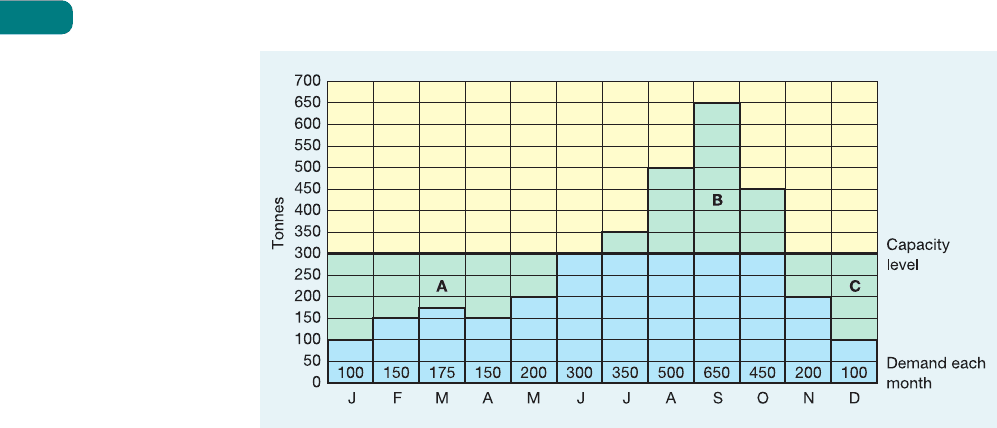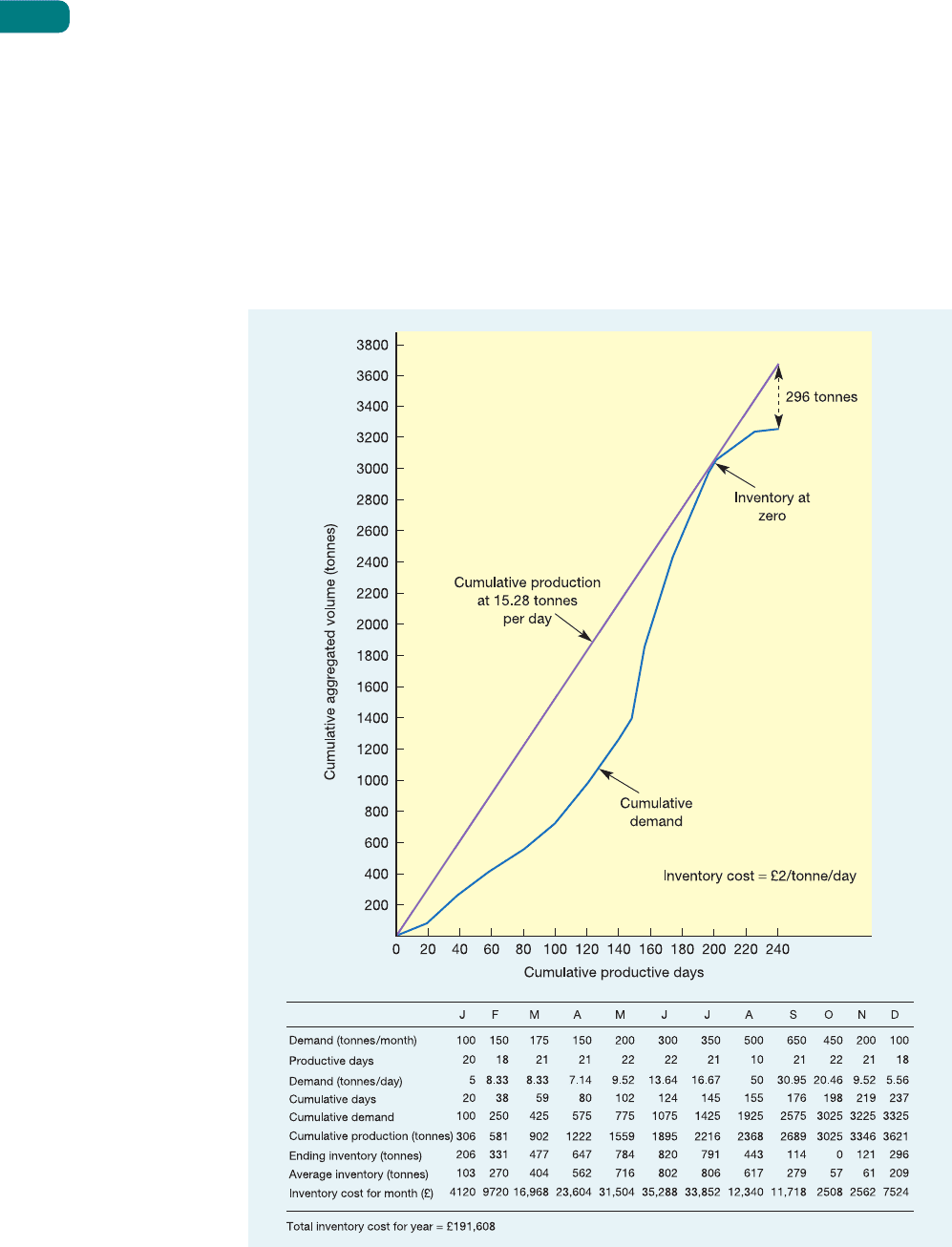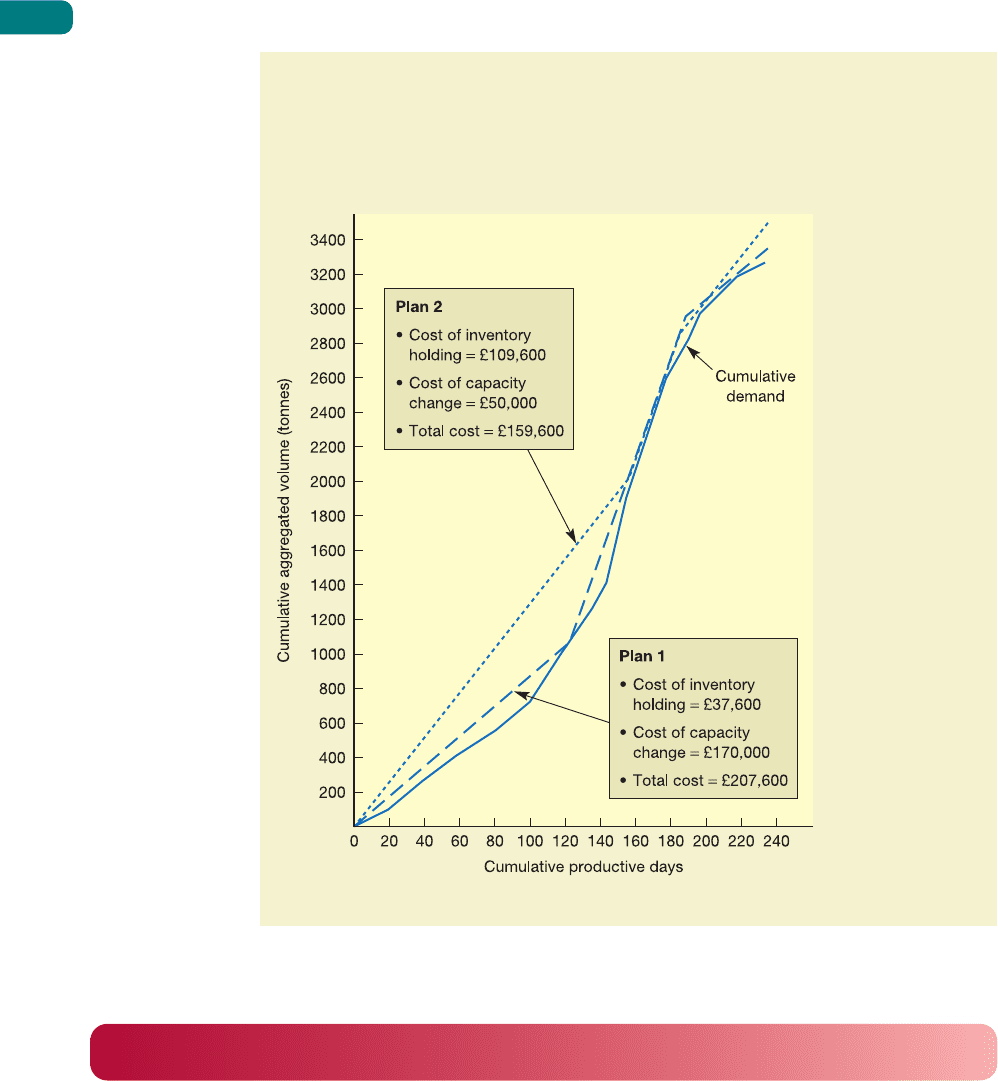Nigel S., Chambers S., Johnson R. Operations Management
Подождите немного. Документ загружается.


as described below in the Short case ‘Working by the year’, are one way of flexing working
hours without excessive extra costs.
Varying the size of the workforce
If capacity is largely governed by workforce size, one way to adjust it is to adjust the size of
the workforce. This is done by hiring extra staff during periods of high demand and laying
them off as demand falls, or hire and fire. However, there are cost and ethical implications
to be taken into account before adopting such a method. The costs of hiring extra staff
include those associated with recruitment, as well as the costs of low productivity while
new staff go through the learning curve. The costs of lay-off may include possible severance
payments, but might also include the loss of morale in the operation and loss of goodwill
in the local labour market. At a micro-operation level, one method of coping with peaks in
demand in one area of an operation is to build sufficient flexibility into job design and job
demarcation so that staff can transfer across from less busy parts of the operation. For example,
the French hotel chain Novotel has trained some of its kitchen staff to escort customers from
the reception area up to their rooms. The peak times for registering new customers coincide
with the least busy times in the kitchen and restaurant areas.
Using part-time staff
A variation on the previous strategy is to recruit part-time staff, that is, for less than the normal
working day. This method is extensively used in service operations such as supermarkets and
fast-food restaurants but is also used by some manufacturers to staff an evening shift after the
normal working day. However, if the fixed costs of employment for each employee, irrespective
of how long he or she works, are high then using this method may not be worthwhile.
Subcontracting
In periods of high demand, an operation might buy capacity from other organizations,
called subcontracting. This might enable the operation to meet its own demand without the
extra expense of investing in capacity which will not be needed after the peak in demand
has passed. Again, there are costs associated with this method. The most obvious one is that
subcontracting can be very expensive. The subcontractor will also want to make sufficient
margin out of the business. A subcontractor may not be as motivated to deliver on time or
to the desired levels of quality. Finally, there is the risk that the subcontractors might them-
selves decide to enter the same market.
Manage demand plan
The most obvious mechanism of demand management is to change demand through price.
Although this is probably the most widely applied approach in demand management, it is
less common for products than for services. For example, some city hotels offer low-cost ‘city
break’ vacation packages in the months when fewer business visitors are expected. Skiing and
Part Three Planning and control
314
To many, the idea of fluctuating the workforce to match demand, either by using part-time
staff or by hiring and firing, is more than just controversial. It is regarded as unethical.
It is any business’s responsibility, they argue, to engage in a set of activities which are
capable of sustaining employment at a steady level. Hiring and firing merely for seasonal
fluctuations, which can be predicted in advance, is treating human beings in a totally
unacceptable manner. Even hiring people on a short-term contract, in practice, leads to
them being offered poorer conditions of service and leads to a state of permanent anxiety
as to whether they will keep their jobs. On a more practical note, it is pointed out that,
in an increasingly global business world where companies may have sites in different
countries, those countries that allow hiring and firing are more likely to have their plants
‘downsized’ than those where legislation makes this difficult.
Critical commentary
Hire and fire
Part-time staff
Subcontracting
Demand management
Change demand
M11A_SLAC0460_06_SE_C11A.QXD 10/20/09 9:34 Page 314

Alternative products and services
Sometimes, a more radical approach is required to fill periods of low demand such as devel-
oping alternative products or services which can be produced on existing processes, but have
different demand patterns throughout the year (see the Short case ‘Getting the message’ for
an example of this approach). Most universities fill their accommodation and lecture theatres
with conferences and company meetings during vacations. Ski resorts provide organized
mountain activity holidays in the summer. Some garden tractor companies in the US now
make snow movers in the autumn and winter. The apparent benefits of filling capacity in this
way must be weighted against the risks of damaging the core product or service, and the
operation must be fully capable of serving both markets. Some universities have been
criticized for providing sub-standard, badly decorated accommodation which met the needs
of impecunious undergraduates, but which failed to impress executives at a trade conference.
Mixed plans
Each of the three ‘pure’ plans is applied only where its advantages strongly outweigh its dis-
advantages. For many organizations, however, these ‘pure’ approaches do not match their
required combination of competitive and operational objectives. Most operations managers
are required simultaneously to reduce costs and inventory, to minimize capital investment,
and yet to provide a responsive and customer-oriented approach at all times. For this reason,
most organizations choose to follow a mixture of the three approaches. This can be best
illustrated by the woollen knitwear company example (see Fig. 11.11). Here some of the peak
demand has been brought forward by the company offering discounts to selected retail
Chapter 11 Capacity planning and control
315
One method of fluctuating capacity as demand
varies throughout the year without many of the costs
associated with overtime or hiring temporary staff is
called the Annual Hours Work Plan. This involves staff
contracting to work a set number of hours per year rather
than a set number of hours per week. The advantage
of this is that the amount of staff time available to
an organization can be varied throughout the year
to reflect the real state of demand. Annual hours plans
can also be useful when supply varies throughout
the year. For example, a UK cheese factory of Express
Foods, like all cheese factories, must cope with
processing very different quantities of milk at different
times of the year. In spring and during early summer,
cows produce large quantities of milk, but in late
summer and autumn the supply of milk slows to a trickle.
Before the introduction of annualized hours, the factory
Short case
Working by the year
4
had relied on overtime and hiring temporary workers
during the busy season. Now the staff are contracted to
work a set number of hours a year with rotas agreed more
than a year in advance and after consultation with the
union. This means that at the end of July staff broadly
know what days and hours they will be working up to
September of the following year. If an emergency should
arise, the company can call in people from a group of
‘super crew’ who work more flexible hours in return for
higher pay but can do any job in the factory.
However, not all experiments with annualized hours
have been as successful as that at Express Foods.
In cases where demand is very unpredictable, staff
can be asked to come in to work at very short notice.
This can cause considerable disruption to social and
family life. For example, at one news-broadcasting
company, the scheme caused problems. Journalists and
camera crew who went to cover a foreign crisis found that
they had worked so many hours they were asked to take
the whole of one month off to compensate. Since they
had no holiday plans, many would have preferred to work.
Alternative products
camping holidays are cheapest at the beginning and end of the season and are particularly
expensive during school vacations. Discounts are given by photo-processing firms during
winter periods, but never around summer holidays. Ice cream is ‘on offer’ in many super-
markets during the winter. The objective is invariably to stimulate off-peak demand and to
constrain peak demand, in order to smooth demand as much as possible. Organizations can
also attempt to increase demand in low periods by appropriate advertising. For example,
turkey growers in the UK and the USA make vigorous attempts to promote their products at
times other than Christmas and Thanksgiving.
M11A_SLAC0460_06_SE_C11A.QXD 10/20/09 9:34 Page 315

customers (manage demand plan). Capacity has also been adjusted at two points in the year
to reflect the broad changes in demand (chase demand plan). Yet the adjustment in capacity
is not sufficient to avoid totally the build-up of inventories (level capacity plan).
Yield management
In operations which have relatively fixed capacities, such as airlines and hotels, it is important
to use the capacity of the operation for generating revenue to its full potential. One approach
used by such operations is called yield management.
5
This is really a collection of methods,
some of which we have already discussed, which can be used to ensure that an operation
maximizes its potential to generate profit. Yield management is especially useful where:
● capacity is relatively fixed;
● the market can be fairly clearly segmented;
● the service cannot be stored in any way;
● the services are sold in advance;
● the marginal cost of making a sale is relatively low.
Airlines, for example, fit all these criteria. They adopt a collection of methods to try to
maximize the yield (i.e. profit) from their capacity. These include the following:
● Over-booking capacity. Not every passenger who has booked a place on a flight will actu-
ally show up for the flight. If the airline did not fill this seat it would lose the revenue from
it. Because of this, airlines regularly book more passengers onto flights than the capacity
of the aircraft can cope with. If they over-book by the exact number of passengers who
fail to show up, they have maximized their revenue under the circumstances. Of course,
if more passengers show up than they expect, the airline will have a number of upset
passengers to deal with (although they may be able to offer financial inducements for
the passengers to take another flight). If they fail to over-book sufficiently, they will have
empty seats. By studying past data on flight demand, airlines try to balance the risks of
over-booking and under-booking.
Part Three Planning and control
316
Figure 11.11 A mixed capacity plan for the woollen knitwear factory
Yield management
Source: Corbis
M11A_SLAC0460_06_SE_C11A.QXD 10/20/09 9:34 Page 316

Chapter 11 Capacity planning and control
317
Companies which traditionally operate in seasonal
markets can demonstrate some considerable ingenuity
in their attempts to develop counter-seasonal products.
One of the most successful industries in this respect has
been the greetings card industry. Mother’s Day, Father’s
Day, Halloween, Valentine’s Day and other occasions
have all been promoted as times to send (and buy)
appropriately designed cards. Now, having run out of
occasions to promote, greetings card manufacturers
have moved on to ‘non-occasion’ cards, which can be
sent at any time. These have the considerable advantage
of being less seasonal, thus making the companies’
seasonality less marked.
Hallmark Cards, the market leader in North America,
has been the pioneer in developing non-occasion cards.
Their cards include those intended to be sent from a
parent to a child with messages such as ‘Would a hug
help?’, ‘Sorry I made you feel bad’ and ‘You’re perfectly
wonderful – it’s your room that’s a mess’. Other cards
deal with more serious adult themes such as friendship
(‘You’re more than a friend, you’re just like family’) or
even alcoholism (‘This is hard to say, but I think you’re
a much neater person when you’re not drinking’). Now
Hallmark Cards has founded a ‘loyalty marketing group’
that ‘helps companies communicate with their customers
at an emotional level’. It promotes the use of greetings
cards for corporate use, to show that customers and
Short case
Getting the message
6
employees are valued. Whatever else these products
may be, they are not seasonal!
● Price discounting. At quiet times, when demand is unlikely to fill capacity, airlines will
also sell heavily discounted tickets to agents who then themselves take the risk of finding
customers for them. In effect, this is using the price mechanism to affect demand.
● Varying service types. Discounting and other methods of affecting demand are also adjusted
depending on the demand for particular types of service. For example, the relative demand
for first-, business- and economy-class seats varies throughout the year. There is no point
discounting tickets in a class for which demand will be high. Yield management also tries
to adjust the availability of the different classes of seat to reflect their demand. They will
also vary the number of seats available in each class by upgrading or even changing the
configuration of airline seats.
Choosing a capacity planning and control approach
Before an operation can decide which of the capacity plans to adopt, it must be aware of
the consequences of adopting each plan in its own set of circumstances. Two methods are
particularly useful in helping to assess the consequences of adopting particular capacity
plans:
● cumulative representations of demand and capacity;
● queuing theory.
Cumulative
representations
Queuing theory
Source: Press Association Images
M11A_SLAC0460_06_SE_C11A.QXD 10/20/09 9:35 Page 317

Cumulative representations
Figure 11.12 shows the forecast aggregated demand for a chocolate factory which makes
confectionery products. Demand for its products in the shops is greatest at Christmas. To
meet this demand and allow time for the products to work their way through the distribu-
tion system, the factory must supply a demand which peaks in September, as shown. One
method of assessing whether a particular level of capacity can satisfy the demand would
be to calculate the degree of over-capacity below the graph which represents the capacity
levels (areas A and C) and the degree of under-capacity above the graph (area B). If the total
over-capacity is greater than the total under-capacity for a particular level of capacity, then
that capacity could be regarded as adequate to satisfy demand fully, the assumption being
that inventory has been accumulated in the periods of over-capacity. However, there are
two problems with this approach. The first is that each month shown in Figure 11.12 may
not have the same amount of productive time. Some months (August, for example) may
contain vacation periods which reduce the availability of capacity. The second problem is
that a capacity level which seems adequate may only be able to supply products after the
demand for them has occurred. For example, if the period of under-capacity occurred at the
beginning of the year, no inventory could have accumulated to meet demand. A far superior
way of assessing capacity plans is first to plot demand on a cumulative basis. This is shown as
the thicker line in Figure 11.13.
The cumulative representation of demand immediately reveals more information. First,
it shows that although total demand peaks in September, because of the restricted number
of available productive days, the peak demand per productive day occurs a month earlier in
August. Second, it shows that the fluctuation in demand over the year is even greater than
it seemed. The ratio of monthly peak demand to monthly lowest demand is 6.5:1, but the
ratio of peak to lowest demand per productive day is 10:1. Demand per productive day is
more relevant to operations managers, because productive days represent the time element
of capacity.
The most useful consequence of plotting demand on a cumulative basis is that, by plotting
capacity on the same graph, the feasibility and consequences of a capacity plan can be assessed.
Figure 11.13 also shows a level capacity plan which produces at a rate of 14.03 tonnes per
productive day. This meets cumulative demand by the end of the year. It would also pass our
earlier test of total over-capacity being the same as or greater than under-capacity.
Part Three Planning and control
318
Figure 11.12 If the over-capacity areas (A+C) are greater than the under-capacity area (B),
the capacity level seems adequate to meet demand. This may not necessarily be the case,
however
M11A_SLAC0460_06_SE_C11A.QXD 10/20/09 9:35 Page 318

However, if one of the aims of the plan is to supply demand when it occurs, the plan is
inadequate. Up to around day 168, the line representing cumulative production is above
that representing cumulative demand. This means that at any time during this period,
more product has been produced by the factory than has been demanded from it. In fact
the vertical distance between the two lines is the level of inventory at that point in time.
So by day 80, 1,122 tonnes have been produced but only 575 tonnes have been demanded.
The surplus of production above demand, or inventory, is therefore 547 tonnes. When the
cumulative demand line lies above the cumulative production line, the reverse is true. The
vertical distance between the two lines now indicates the shortage, or lack of supply. So by
day 198, 3,025 tonnes have been demanded but only 2,778 tonnes produced. The shortage
is therefore 247 tonnes.
Chapter 11 Capacity planning and control
319
Figure 11.13 A level capacity plan which produces shortages in spite of meeting demand at
the end of the year
M11A_SLAC0460_06_SE_C11A.QXD 10/20/09 9:35 Page 319

For any capacity plan to meet demand as it occurs, its cumulative production line must
always lie above the cumulative demand line. This makes it a straightforward task to judge
the adequacy of a plan, simply by looking at its cumulative representation. An impression of
the inventory implications can also be gained from a cumulative representation by judging the
area between the cumulative production and demand curves. This represents the amount of
inventory carried over the period. Figure 11.14 illustrates an adequate level capacity plan for
the chocolate manufacturer, together with the costs of carrying inventory. It is assumed that
inventory costs £2 per tonne per day to keep in storage. The average inventory each month
is taken to be the average of the beginning- and end-of-month inventory levels, and the
Part Three Planning and control
320
Figure 11.14 A level capacity plan which meets demand at all times during the year
M11A_SLAC0460_06_SE_C11A.QXD 10/20/09 9:35 Page 320

inventory-carrying cost each month is the product of the average inventory, the inventory cost
per day per tonne and the number of days in the month.
Comparing plans on a cumulative basis
Chase demand plans can also be illustrated on a cumulative representation. Rather than
the cumulative production line having a constant gradient, it would have a varying gradient
representing the production rate at any point in time. If a pure demand chase plan was
adopted, the cumulative production line would match the cumulative demand line. The gap
between the two lines would be zero and hence inventory would be zero. Although this would
eliminate inventory-carrying costs, as we discussed earlier, there would be costs associated
with changing capacity levels. Usually, the marginal cost of making a capacity change increases
with the size of the change. For example, if the chocolate manufacturer wishes to increase
capacity by 5 per cent, this can be achieved by requesting its staff to work overtime – a simple,
fast and relatively inexpensive option. If the change is 15 per cent, overtime cannot provide
sufficient extra capacity and temporary staff will need to be employed – a more expensive
solution which also would take more time. Increases in capacity of above 15 per cent might
only be achieved by subcontracting some work out. This would be even more expensive. The
cost of the change will also be affected by the point from which the change is being made,
as well as the direction of the change. Usually, it is less expensive to change capacity towards
what is regarded as the ‘normal’ capacity level than away from it.
Chapter 11 Capacity planning and control
321
Suppose the chocolate manufacturer, which has been operating the level capacity plan as
shown in Figure 11.15, is unhappy with the inventory costs of this approach. It decides
to explore two alternative plans, both involving some degree of demand chasing.
Plan 1
● Organize and staff the factory for a ‘normal’ capacity level of 8.7 tonnes per day.
● Produce at 8.7 tonnes per day for the first 124 days of the year, then increase capacity
to 29 tonnes per day by heavy use of overtime, hiring temporary staff and some
subcontracting.
● Produce at 29 tonnes per day until day 194, then reduce capacity back to 8.7 tonnes
per day for the rest of the year.
The costs of changing capacity by such a large amount (the ratio of peak to normal
capacity is 3.33:1) are calculated by the company as being:
Cost of changing from 8.7 tonnes/day to 29 tonnes/day = £110,000
Cost of changing from 29 tonnes/day to 8.7 tonnes/day = £60,000
Plan 2
● Organize and staff the factory for a ‘normal’ capacity level of 12.4 tonnes per day.
● Produce at 12.4 tonnes per day for the first 150 days of the year, then increase capacity
to 29 tonnes per day by overtime and hiring some temporary staff.
● Produce at 29 tonnes/day until day 190, then reduce capacity back to 12.4 tonnes per
day for the rest of the year.
The costs of changing capacity in this plan are smaller because the degree of change
is smaller (a peak to normal capacity ratio of 2.34:1), and they are calculated by the
company as being:
Cost of changing from 12.4 tonnes/day to 29 tonnes/day = £35,000
Cost of changing from 29 tonnes/day to 12.4 tonnes/day = £15,000
Worked example
➔
M11A_SLAC0460_06_SE_C11A.QXD 10/20/09 9:35 Page 321

Part Three Planning and control
322
Figure 11.15 illustrates both plans on a cumulative basis. Plan 1, which envisaged two
drastic changes in capacity, has high capacity change costs but, because its production
levels are close to demand levels, it has low inventory carrying costs. Plan 2 sacrifices
some of the inventory cost advantage of Plan 1 but saves more in terms of capacity
change costs.
Figure 11.15 Comparing two alternative capacity plans
Capacity planning as a queuing problem
Cumulative representations of capacity plans are useful where the operation has the ability
to store its finished goods as inventory. However, for operations where it is not possible
to produce products and services before demand for them has occurred, a cumulative repres-
entation would tell us relatively little. The cumulative ‘production’ could never be above
the cumulative demand line. At best, it could show when an operation failed to meets its
demand. So the vertical gap between the cumulative demand and production lines would
indicate the amount of demand unsatisfied. Some of this demand would look elsewhere to
be satisfied, but some would wait. This is why, for operations which, by their nature, cannot
store their output, such as most service operations, capacity planning and control is best
considered using waiting or queuing theory.
Queuing theory
M11A_SLAC0460_06_SE_C11A.QXD 10/20/09 9:35 Page 322

Queuing or ‘waiting line’ management
When we were illustrating the use of cumulative representations for capacity planning and
control, our assumption was that, generally, any production plan should aim to meet demand
at any point in time (the cumulative production line must be above the cumulative demand
line). Looking at the issue as a queuing problem (in many parts of the world queuing con-
cepts are referred to as ‘waiting line’ concepts) accepts that, while sometime demand may
be satisfied instantly, at other times customers may have to wait. This is particularly true
when the arrival of individual demands on an operation are difficult to predict, or the time
to produce a product or service is uncertain, or both. These circumstances make providing
adequate capacity at all points in time particularly difficult. Figure 11.16 shows the general
form of this capacity issue. Customers arrive according to some probability distribution and
wait to be processed (unless part of the operation is idle); when they have reached the front
of the queue, they are processed by one of the n parallel ‘servers’ (their processing time also
being described by a probability distribution), after which they leave the operation. There
are many examples of this kind of system. Table 11.2 illustrates some of these. All of these
examples can be described by a common set of elements that define their queuing behaviour.
The source of customers – sometimes called the calling population – is the source of supply
of customers. In queue management ‘customers’ are not always human. ‘Customers’ could
for example be trucks arriving at a weighbridge, orders arriving to be processed or machines
waiting to be serviced, etc. The source of customers for queuing system can be either finite
or infinite. A finite source has a known number of possible customers. For example, if one
Calling population
Chapter 11 Capacity planning and control
323
Table 11.2 Examples of operations which have parallel processors
Operation Arrivals Processing capacity
Bank Customers Tellers
Supermarket Shoppers Checkouts
Hospital clinic Patients Doctors
Graphic artist Commissions Artists
Custom cake decorators Orders Cake decorators
Ambulance service Emergencies Ambulances with crews
Telephone switchboard Calls Telephonists
Maintenance department Breakdowns Maintenance staff
Figure 11.16 The general form of the capacity decision in queuing systems
M11A_SLAC0460_06_SE_C11A.QXD 10/20/09 9:35 Page 323
